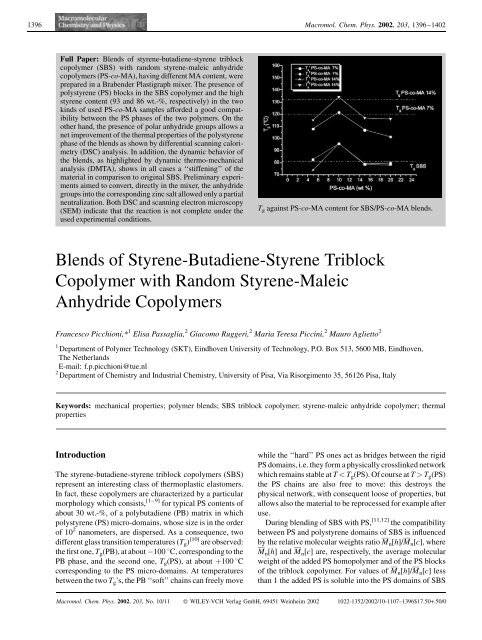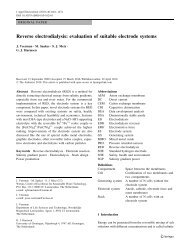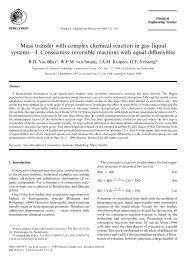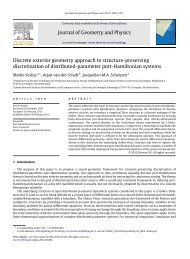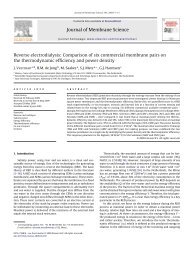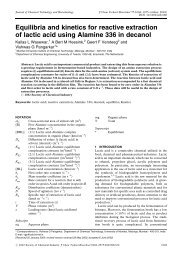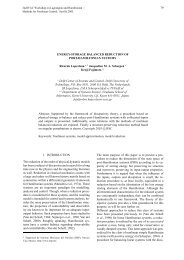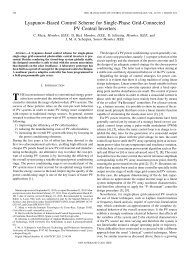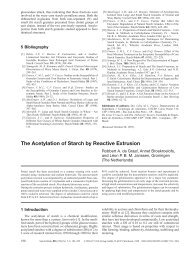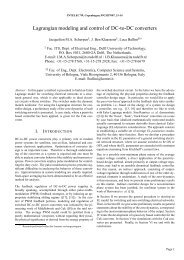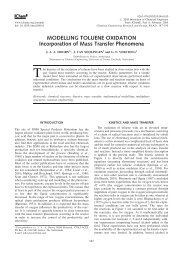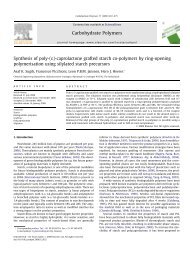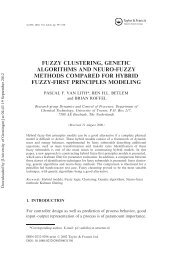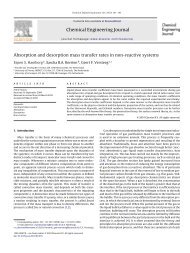Blends of styrene-butadiene-styrene triblock copolymer with ... - ITM
Blends of styrene-butadiene-styrene triblock copolymer with ... - ITM
Blends of styrene-butadiene-styrene triblock copolymer with ... - ITM
Create successful ePaper yourself
Turn your PDF publications into a flip-book with our unique Google optimized e-Paper software.
1396 Macromol. Chem. Phys. 2002, 203, 1396–1402Full Paper: <strong>Blends</strong> <strong>of</strong> <strong>styrene</strong>-<strong>butadiene</strong>-<strong>styrene</strong> <strong>triblock</strong><strong>copolymer</strong> (SBS) <strong>with</strong> random <strong>styrene</strong>-maleic anhydride<strong>copolymer</strong>s (PS-co-MA), having different MA content, wereprepared in a Brabender Plastigraph mixer. The presence <strong>of</strong>poly<strong>styrene</strong> (PS) blocks in the SBS <strong>copolymer</strong> and the high<strong>styrene</strong> content (93 and 86 wt.-%, respectively) in the twokinds <strong>of</strong> used PS-co-MA samples afforded a good compatibilitybetween the PS phases <strong>of</strong> the two polymers. On theother hand, the presence <strong>of</strong> polar anhydride groups allows anet improvement <strong>of</strong> the thermal properties <strong>of</strong> the poly<strong>styrene</strong>phase <strong>of</strong> the blends as shown by differential scanning calorimetry(DSC) analysis. In addition, the dynamic behavior <strong>of</strong>the blends, as highlighted by dynamic thermo-mechanicalanalysis (DMTA), shows in all cases a ‘‘stiffening’’ <strong>of</strong> thematerial in comparison to original SBS. Preliminary experimentsaimed to convert, directly in the mixer, the anhydridegroups into the corresponding zinc salt allowed only a partialneutralization. Both DSC and scanning electron microscopy(SEM) indicate that the reaction is not complete under theused experimental conditions.T g against PS-co-MA content for SBS/PS-co-MA blends.<strong>Blends</strong> <strong>of</strong> Styrene-Butadiene-Styrene TriblockCopolymer <strong>with</strong> Random Styrene-MaleicAnhydride CopolymersFrancesco Picchioni,* 1 Elisa Passaglia, 2 Giacomo Ruggeri, 2 Maria Teresa Piccini, 2 Mauro Aglietto 21 Department <strong>of</strong> Polymer Technology (SKT), Eindhoven University <strong>of</strong> Technology, P.O. Box 513, 5600 MB, Eindhoven,The NetherlandsE-mail: f.p.picchioni@tue.nl2 Department <strong>of</strong> Chemistry and Industrial Chemistry, University <strong>of</strong> Pisa, Via Risorgimento 35, 56126 Pisa, ItalyKeywords: mechanical properties; polymer blends; SBS <strong>triblock</strong> <strong>copolymer</strong>; <strong>styrene</strong>-maleic anhydride <strong>copolymer</strong>; thermalpropertiesIntroductionThe <strong>styrene</strong>-<strong>butadiene</strong>-<strong>styrene</strong> <strong>triblock</strong> <strong>copolymer</strong>s (SBS)represent an interesting class <strong>of</strong> thermoplastic elastomers.In fact, these <strong>copolymer</strong>s are characterized by a particularmorphology which consists, [1–9] for typical PS contents <strong>of</strong>about 30 wt.-%, <strong>of</strong> a poly<strong>butadiene</strong> (PB) matrix in whichpoly<strong>styrene</strong> (PS) micro-domains, whose size is in the order<strong>of</strong> 10 2 nanometers, are dispersed. As a consequence, twodifferent glass transition temperatures (T g ) [10] are observed:the first one, T g (PB), at about 100 8C, corresponding to thePB phase, and the second one, T g (PS), at about þ100 8Ccorresponding to the PS micro-domains. At temperaturesbetween the two T g ’s, the PB ‘‘s<strong>of</strong>t’’ chains can freely movewhile the ‘‘hard’’ PS ones act as bridges between the rigidPS domains, i.e. they form a physically crosslinked networkwhich remains stable at T < T g (PS). Of course at T > T g (PS)the PS chains are also free to move: this destroys thephysical network, <strong>with</strong> consequent loose <strong>of</strong> properties, butallows also the material to be reprocessed for example afteruse.During blending <strong>of</strong> SBS <strong>with</strong> PS, [11,12] the compatibilitybetween PS and poly<strong>styrene</strong> domains <strong>of</strong> SBS is influencedby the relative molecular weights ratio M n [h]/M n [c], whereM n [h] and M n [c] are, respectively, the average molecularweight <strong>of</strong> the added PS homopolymer and <strong>of</strong> the PS blocks<strong>of</strong> the <strong>triblock</strong> <strong>copolymer</strong>. For values <strong>of</strong> M n [h]/M n [c] lessthan 1 the added PS is soluble into the PS domains <strong>of</strong> SBSMacromol. Chem. Phys. 2002, 203, No. 10/11 ß WILEY-VCH Verlag GmbH, 69451 Weinheim 2002 1022-1352/2002/10-1107–1396$17.50+.50/0
<strong>Blends</strong> <strong>of</strong> Styrene-Butadiene-Styrene Triblock Copolymer ... 1397but very slight improvement <strong>of</strong> the thermal properties isobserved. On the other hand, when M n [h]/M n [c] 1, thesolubility may be lower than in the previous case, but synergismin the thermal and dynamic behavior could clearlybe observed, for example comparing the blends T g <strong>with</strong>those <strong>of</strong> the pure components. In particular, these resultswere tentatively explained [11] on the basis <strong>of</strong> entanglementformation between the two components upon mixing,although no experimental confirmation <strong>of</strong> such hypothesiswas presented. An even more pronounced improvement <strong>of</strong>the thermal behavior could be observed if polar groups wereinserted into the PS domains <strong>of</strong> the <strong>triblock</strong> <strong>copolymer</strong>either by direct chemical modification [13–17] or by blendingprocesses. [18] In particular, the sulfonation reaction <strong>of</strong><strong>styrene</strong>-ethylene/1-butene-<strong>styrene</strong> (SEBS) <strong>triblock</strong> <strong>copolymer</strong><strong>with</strong> consequent neutralization <strong>of</strong> the sulfonic acidmoieties represents a convenient route to introduce ionicinteractions in the PS ‘‘hard’’ phase. [13] The obtained morphology(Scheme 1) consists <strong>of</strong> ionomeric domains dispersedin the PS phase which shows a new transition, [14] dueto the relaxation <strong>of</strong> the ionomeric domains, at T > T g (PS).The overall result is anyway an improvement <strong>of</strong> the thermaland mechanical properties <strong>with</strong> respect to those <strong>of</strong> the neat<strong>triblock</strong> <strong>copolymer</strong>.Random <strong>styrene</strong>-maleic anhydride <strong>copolymer</strong>s (PS-co-MA), for which a detailed characterization <strong>of</strong> the randomdistribution <strong>of</strong> the MA comonomer was described onlyrecently, [19,20] are attractive materials to be blended <strong>with</strong>SBS since, for low MA content, they could afford a goodsolubility into the SBS ‘‘hard’’ phase while carrying at thesame time polar anhydride groups, which can be then convertedinto ionic species. Aim <strong>of</strong> this work was therefore toinvestigate the thermal and mechanical behaviors <strong>of</strong> theabove-mentioned blends in particular as a function <strong>of</strong> theblends composition and MA content in the PS-co-MA <strong>copolymer</strong>s.Furthermore, in order to introduce ionic interactionsin the system, some preliminary experiments on theneutralization <strong>of</strong> the anhydride groups by zinc acetateZn(OAc) 2 directly in dynamic conditions, i.e. during meltmixing <strong>with</strong> SBS, were performed.Experimental PartPolymersThe block <strong>copolymer</strong> SBS (Calprene 501, S<strong>of</strong>ter S.p.A, Forlì,Italy) was employed <strong>with</strong>out further purification. It wascharacterized by a <strong>butadiene</strong>/<strong>styrene</strong> ratio <strong>of</strong> 69/31 (w/w),blocks average molecular weight 9 300-41 400-9 300 <strong>with</strong>M w /M n ¼ 1.5 and vinyl units in the <strong>butadiene</strong> block <strong>of</strong>10 wt.-% <strong>with</strong> respect to the total amount <strong>of</strong> <strong>butadiene</strong> units.Two samples <strong>of</strong> PS-co-MA (Aldrich) were used <strong>with</strong>outfurther purification. PS-co-MA 7% was characterized by thepresence <strong>of</strong> 7 wt.-% maleic anhydride groups, melt index(230 8C, 16 kg, ASTM D 1238) <strong>of</strong> 1.7 g/10 min and M w ¼2.2 10 5 . On the other hand, PS-co-MA 14 % was characterizedby the presence <strong>of</strong> 14 wt.-% maleic anhydride groups,melt index (230 8C, 16 kg, ASTM D 1238) <strong>of</strong> 1.9 g/10 min andM w ¼ 2.0 10 5 . Both <strong>copolymer</strong>s were characterized beforeuse by means <strong>of</strong> FT-IR analysis.Zinc acetate dihydrate, Zn(OAc) 2 2H 2 O, from Rudipont,RGC grade, was used <strong>with</strong>out further purification.CharacterizationFT-Infrared analysis: infrared spectra were performed by aFourier Transform Spectrometer ‘‘Perkin Elmer FT-IR 1750’’on films cast from a solvent solution on a KBr pellet.Differential scanning calorimetry: DSC analyses wereperformed by a ‘‘Perkin Elmer DSC7’’ calorimeter equipped<strong>with</strong> a CCA7 cooling device. Mercury (m.p. 38.4 8C)and Indium (m.p. 156.2 8C) standards for low-temperaturescans and Indium and Zinc (m.p. 419.5 8C) for high-temperatureones have been used for instrument calibration.Heating and cooling thermograms were carried out at standardrate <strong>of</strong> 20 8C/min.Thermogravimetric analysis: all TGA thermograms wererecorded by a Mettler TC11 instrument equipped <strong>with</strong> aMettler M3 balance <strong>with</strong> an accuracy <strong>of</strong> 10 3 mg. Heatingthermograms were carried out at a standard rate <strong>of</strong> 10 8C/minunder dry nitrogen atmosphere.Scanning electron microscopy analysis: all SEM micrographswere recorded on samples cryogenic fracture surfacesby a Jeol JSM mod.T-300 instrument at the Chemical EngineeringDepartment <strong>of</strong> Pisa University.Dynamic-mechanical thermograms (DMTA) were recordedby a Perkin-Elmer DMA7e instrument (three-point bendinggeometry). Thermograms were carried out at a standard heatingrate <strong>of</strong> 1 8C/min and 1 Hz.Preparation <strong>of</strong> <strong>Blends</strong> in the Brabender MixerScheme 1. Schematic representation <strong>of</strong> sulfonated-SEBSmorphology.The blends (SBS/PS-co-MA x% w/w, <strong>with</strong> x ¼ 7, 14) wereprepared in a Brabender Plastograph mixer under nitrogenatmosphere by introducing the desired amounts <strong>of</strong> the componentsin the mixer at 180 8C, rotor speed 50 rpm. After10 min, the mixing was stopped and the materials recovered.The blends <strong>with</strong> zinc acetate, Zn(OAc) 2 , were preparedaccording to the above-mentioned procedure; the calculatedstoichiometric amount <strong>of</strong> the salt, <strong>with</strong> respect to the totalamount <strong>of</strong> maleic anhydride groups, was added together <strong>with</strong>the polymers directly into the mixer.
1398 F. Picchioni, E. Passaglia, G. Ruggeri, M. T. Piccini, M. AgliettoResults and DiscussionBefore blending SBS <strong>with</strong> PS-co-MA, attention wasdedicated to the chemical characterization <strong>of</strong> PS-co-MA:in particular, the presence <strong>of</strong> carboxylic acid groups, whichcould be formed by hydrolysis, was investigated because <strong>of</strong>the possible influence on the miscibility. [18] The FT-IRanalysis <strong>of</strong> the two PS-co-MA samples shows the presence<strong>of</strong> the characteristic absorptions at 1 780 cm 1 and1 858 cm 1 due to symmetric and asymmetric stretching <strong>of</strong>anhydride group, and the absence <strong>of</strong> carboxylic acid characteristicabsorptions demonstrating that no appreciablehydrolysis <strong>of</strong> anhydride groups has occurred.<strong>Blends</strong> <strong>of</strong> SBS and PS-co-MA were prepared using anexcess <strong>of</strong> SBS and, in particular, PS-co-MA concentrations<strong>of</strong> 5, 10, 15, and 20 wt.-% were used. All blends display(Table 1) two glass transitions temperatures at T over roomtemperature, thus indicating that two hard phases are formedupon melt mixing. The first transition (T g 1 ) is close to that<strong>of</strong> SBS hard phase and can be assigned to a PS-rich phase<strong>with</strong> a low content <strong>of</strong> anhydride groups, while the secondone (T g 2 ) is quite similar to that <strong>of</strong> PS-co-MA so that it can berelated to a PS-rich phase <strong>with</strong> high MA content. Byplotting T g values against blends composition (Figure 1) amaximum at 10 wt.-% PS-co-MA content is observed inall cases. This behavior held for the glass transition temperatures<strong>of</strong> the two hard phases and clearly indicates asynergism in the thermal properties for the 90/10 compositionssince the T g ’s for these blends are indeed even higherthan those <strong>of</strong> the neat components. However, there seems tobe no influence <strong>of</strong> the MA content in the PS-co-MA sinceTable 1.blends.DSC analysis (high temperatures) <strong>of</strong> SBS/PS-co-MARun a,b) T 1 g T 2 g c)SBS 80.1 –PS-co-MA 7% – 120.0PS-co-MA 14% – 132.0SBS/PS-co-MA 7% 95/5 82.7 108.1SBS/PS-co-MA 7% 90/10 95.6 121.6SBS/PS-co-MA 7% 85/15 79.0 107.1SBS/PS-co-MA 7% 80/20 79.5 101.6SBS/PS-co-MA 14% 95/5 73.8 115.1SBS/PS-co-MA 14% 90/10 95.7 134.2SBS/PS-co-MA 14% 85/15 78.9 117.0SBS/PS-co-MA 14% 80/20 78.1 116.0SBS/PS-co-MA 7% þ Zn(OAc) 2 90/10 88.7 n.d.SBS/PS-co-MA 7% þ Zn(OAc) 2 80/20 79.6 101.7SBS/PS-co-MA 14% þ Zn(OAc) 2 90/10 88.3 n.d.SBS/PS-co-MA 14% þ Zn(OAc) 2 80/20 77.7 118.28C8CFigure 1.blends.T g against PS-co-MA content for SBS/PS-co-MAmaximums are always detected for 10 wt.-% <strong>of</strong> the random<strong>copolymer</strong>.The morphology <strong>of</strong> the blends, as detected by SEM (somerepresentative micrographs are reported in Figure 2),reveals the presence <strong>of</strong> at least two phases: a matrix inwhich white domains, which correspond [11] to the hardPS phases, are dispersed. However, the possibility <strong>of</strong> bothmicrophase separation <strong>with</strong>in the PS domains and <strong>of</strong> themacrophase segregation <strong>of</strong> PS-co-MA (especially for highPS-co-MA contents) cannot be excluded and may renderthe morphology much more complicated at more microscopiclevel. In any case, macrophase separation occurs notdepending on blend composition and MA content in the<strong>copolymer</strong>, since all SEM micrographs are similar to eachother.<strong>Blends</strong>, characterized by means <strong>of</strong> TGA analysis(Table 2), show a degradation temperature (T d ) quitesimilar to that <strong>of</strong> neat SBS thus indicating that melt blendingdoes not appreciably modify SBS thermal stability.Moreover, higher PS-co-MA content in the blends causes adecrease <strong>of</strong> T d .DMTA data (Table 3) outline the increase <strong>of</strong> the blendsT g , determined as onset in the storage modulus vs. tem-a <strong>Blends</strong> composition is expressed in weight ratios.b) Zinc acetate was used in stoichiometric amount <strong>with</strong> respect tothe anhydride groups.c) Evaluated from 2 nd -heat curves.Figure 2.SEM micrographs <strong>of</strong> SBS/PS-co-MA blends.
<strong>Blends</strong> <strong>of</strong> Styrene-Butadiene-Styrene Triblock Copolymer ... 1399Table 2.TGA analysis <strong>of</strong> SBS/PS-co-MA blends.Sample a) T db)SBS 430PS-co-MA 7% 389PS-co-MA 14% 375SBS/PS-co-MA 7% 90/10 432SBS/PS-co-MA 7% 80/20 402SBS/PS-co-MA 14% 90/10 435SBS/PS-co-MA 14% 80/20 419a) <strong>Blends</strong> composition is expressed in weight ratios.b) Evaluated as upturn point <strong>of</strong> TGA 1 st -derivative curve.8CFigure 3.Tan(d) curves for SBS/PS-co-MA 7% blends.perature curves, <strong>with</strong> respect to that <strong>of</strong> neat SBS. The sameobservation can be extrapolated from the maximums <strong>of</strong>tan(d) curves (Figure 3 and 4), which shift in generaltowards high temperature <strong>with</strong> respect to the virgin SBS.Moreover, blends <strong>with</strong> 5–10 wt.-% <strong>of</strong> PS-co-MA arecharacterized by the highest tan(d) peak temperatures <strong>with</strong>respect to the other compositions. It must also be stressedthat the evident broadening <strong>of</strong> tan(d) peak correspondingto a 10 wt.-% PS-co-MA substantially agrees <strong>with</strong> whatalready has been reported in the literature [21] about similarsystems and strongly addresses the synergism <strong>of</strong> propertiesfor this particular composition. The relative decrease <strong>of</strong> thestorage modulus in correspondence to the glass transitiontemperature <strong>of</strong> the blends hard phase displays its minimumvalues for the 90/10 compositions clearly indicating thatthese blends are much stiffer than the pure <strong>copolymer</strong> andthe other mixtures. The fact that synergism takes place moreevidently in correspondence <strong>of</strong> the 90/10 composition maysuggest that in this case probably a saturation <strong>of</strong> the PSTable 3.DMTA analysis <strong>of</strong> SBS/PS-co-MA blends.Sample a) T g tan(d) DE/E b) DT b)domains interface by the PS-co-MA component has alreadybeen achieved. Accordingly, for higher PS-co-MA contents,a new PS-rich phase could be formed by the excessPS-co-MA leading to phase separation and worsening <strong>of</strong> themechanical properties. This hypothesis is in agreement towhat already has been suggested in the literature [22] aboutSBS/PS blends, the only difference being in the fact that thesolubility-limiting factor is not, in our case, the molecularweight <strong>of</strong> the added component but its amount <strong>with</strong> respectto the SBS <strong>triblock</strong> <strong>copolymer</strong>.Some preliminary attempts to neutralize the MA groupsin dynamic conditions, i.e. during processing, were performedby adding a stoichiometric amount <strong>of</strong> Zn(OAc) 2directly into the mixer together <strong>with</strong> the two polymers.FT-IR spectra <strong>of</strong> the ‘‘neutralized blends’’ (Figure 5and 6) show the presence <strong>of</strong> bands characteristic <strong>of</strong> thezinc-neutralized anhydride groups (at around 1 560 and1 630 cm 1 ) [23,24] but also those <strong>of</strong> the unreacted MAgroups, i.e. the neutralization reaction was not completeunder the experimental conditions used. DSC analysiscarried out on these blends (Table 1) shows a quiteanomalous behavior. In fact, when using 10 wt.-% <strong>of</strong> PSco-MAonly one T g was clearly detectable by DSC after8C 8C % 8CSBS 64.6 78.2 82.8 50–78SBS/PS-co-MA 7% 95/5 86.8 98.9 87.9 50–100SBS/PS-co-MA 7% 90/10 80.0 94.6 31.2 50–80SBS/PS-co-MA 7% 85/15 78.2 93.8 n.d –SBS/PS-co-MA 7% 80/20 76.0 83.6 60.2 50–80SBS/PS-co-MA 14% 95/5 87.7 98.5 53.2 50–80SBS/PS-co-MA 14% 90/10 88.0 100.2 28.5 50–100SBS/PS-co-MA 14% 85/15 76.2 97.5 28.4 50–80SBS/PS-co-MA 14% 80/20 72.3 83.5 73.5 50–80a) <strong>Blends</strong> composition is expressed in weight ratios.b) Relative decrease <strong>of</strong> the storage modulus (DE/E) calculatedas E1 ðT 1Þ E 1 ðT 2ÞE 1 ðT 1Þ 100 where the T 1 T 2 ¼ DT range has beenchosen in order to comprise the hard phases glass transitiontemperature.Figure 4.Tan(d) curves for SBS/PS-co-MA 14% blends.
1400 F. Picchioni, E. Passaglia, G. Ruggeri, M. T. Piccini, M. AgliettoFigure 5. FT-IR spectra <strong>of</strong> SBS/PS-co-MA 7% 90/10 and SBS/PS-co-MA 7% 90/10 þ Zn(OAc) 2 .neutralization, and its value is about 10 8C higher than theT g <strong>of</strong> PS blocks in SBS. On the other hand, for blends <strong>with</strong>20 wt.-% <strong>of</strong> PS-co-MA, two transitions are clearly detectable:the first one at about 80 8C is lower than T g (PS), whilethe second one is in any case lower than the T g <strong>of</strong> the correspondingPS-co-MA. It must be stressed that the broadening<strong>of</strong> the T g in the presence <strong>of</strong> ionomeric species, asalready reported in the literature, [13,14,21] creates substantialdifficulties in the exact determination <strong>of</strong> the transitiontemperature and in general in the distinction <strong>with</strong>in multipletransitions in a narrow temperature range. It is then possibleonly to outline, as a general trend, the fact that the neutralization<strong>of</strong> MA groups does not affect the blends thermalbehavior in a positive way: comparison <strong>of</strong> thermal propertiesbetween blends <strong>with</strong> and <strong>with</strong>out addition <strong>of</strong> zincacetate clearly addresses a worsening <strong>of</strong> the thermal behaviorin the former case. This evidence is also confirmedby DMTA data as depicted in Figure 7 for T g values: forFigure 6. FT-IR spectra <strong>of</strong> SBS/PS-co-MA 14% 90/10 and SBS/PS-co-MA 14% 90/10 þ Zn(OAc) 2 .
<strong>Blends</strong> <strong>of</strong> Styrene-Butadiene-Styrene Triblock Copolymer ... 1401Figure 7. T g , as determined by DMTA, for SBS/PS-co-MA byaddition <strong>of</strong> Zn(OAc) 2 .any composition the addition <strong>of</strong> Zn(OAc) 2 results in nomodification or in lower T g values for the blends. Theseconsiderations suggest that an incomplete neutralizationreaction can take place in the mixer resulting in the presence<strong>of</strong> unreacted Zn(OAc) 2 particles.SEM micrographs (Figure 8a) show indeed the presence<strong>of</strong> white domains which correspond [18] to the hard PS phase<strong>of</strong> the blends containing both PS from SBS and PS-co-MA.However, microanalysis for zinc (8b) clearly demonstratesthe presence <strong>of</strong> the latter mostly in the ‘‘hard’’ (white domains).Eventually (8c), when using the maximum amount<strong>of</strong> the salt (SBS/PS-co-MA 14%/Zn(OAc) 2 80/20), it waseven possible to detect the presence <strong>of</strong> unreacted zinc saltparticles.ConclusionsPS-co-MA <strong>copolymer</strong>s blended in the melt <strong>with</strong> SBS<strong>triblock</strong> <strong>copolymer</strong> produced samples characterized by atleast two hard phases. For the used PS-co-MA <strong>copolymer</strong>s,the high M n [h]/M n [c] values, where M n [h] and M n [c] are,respectively, the average molecular weight <strong>of</strong> the PS-co-MA component and that <strong>of</strong> the PS block <strong>of</strong> the <strong>triblock</strong><strong>copolymer</strong>, resulted in the formation <strong>of</strong> two PS-basedphases as clearly evidenced by DSC and SEM analysis. Thefirst SBS hard phase can be assigned to a PS-rich phase <strong>with</strong>a low content <strong>of</strong> anhydride groups while the second one canbe related to a PS-rich phase <strong>with</strong> high MA content.However, even in these unfavorable conditions <strong>of</strong> solubility<strong>of</strong> PS-co-MA into the PS domains <strong>of</strong> SBS, a synergismin the mechanical and thermal properties wasdetected depending on the blends composition. This resultis in agreement <strong>with</strong> what already has been reported in theliterature for very similar systems and addresses anyway the‘‘stiffening’’ <strong>of</strong> the SBS <strong>copolymer</strong> upon mixing as demonstratedby DMTA analysis.Furthermore, the difference in the MA content seems toplay only a minor role in determining the blends thermaland mechanical behavior. Synergistic effects take placealmost for the same blends composition thus suggestingthat the key parameter determining their occurrence is theM n [h]/M n [c] ratio, which is nearly the same for the two usedPS-co-MA samples.Preliminary attempts for the neutralization <strong>of</strong> theanhydride groups directly while processing were unsatisfactory:worse thermal and mechanical properties wereindeed observed <strong>with</strong> respect to the non-neutralized blends.The presence <strong>of</strong> unreacted salt particles is suggested byboth DSC and SEM analysis and confirmed by the analysis<strong>of</strong> the FT-IR spectra, could account for the observedvariations.Received: September 5, 2001Revised: December 5, 2001Figure 8. SEM micrographs <strong>of</strong> SBS/Ps-co-MA/Zn(OAc) 2blends.[1] R. J. Spontak, M. C. Williams, D. A. Agard, Polymer 1988,29, 387.[2] J. J. Jones, R. P. Burford, Polym. Int. 1991, 26, 163.[3] D. B. Scott, A. J. Waddon, Y. Lin, F. E. Karasz, H. H. Winter,Macromolecules 1992, 25, 4175.[4] Y. Zhao, Macromolecules 1992, 25, 4705.[5] S. Sakurai, T. Momii, K. Taie, M. Shibayama, S. Nomura,Macromolecules 1993, 26, 485.[6] S. Sakurai, J. Sakamoto, M. Shibayama, S. Nomura,Macromolecules 1993, 26, 3351.[7] M. A. van Dijk, R. van den Berg, Macromolecules 1995, 28,6773.[8] A. Turturro, E. Gattiglia, P. Vacca, G. T. Viola, Polymer1995, 36, 3987.


